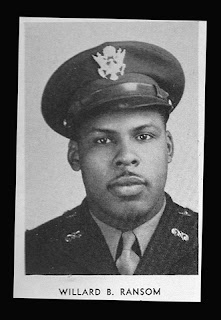On August 3rd of 1944 at the Tuskegee Army Air Field
On August 3rd of 1944 a group of twelve African American
officers led by Captain Willard B. Ransom entered the west dining room of the
Tuskegee Army Air Field (TAAF) Post Exchange restaurant. This restaurant had
been reserved for white officers only. Capt. Ransom and the other officers sat
down and asked to be served. When 2nd Lt. George D Frye the Assistant Exchange
Officer, asked the black officers to go to the larger east dining room which
was reserved for them, Captain Ransom showed Frye two War Department letters
that noted service at base recreational facilities and post exchanges would not
be denied to any personnel because of race.
With Col. Noel Parrish’s support, Lt. Frye agreed to let the
black officers be served in the west dining room, effectively integrating the
restaurant without violence. Unfortunately many white officers stopped eating
at the facility. Also the elimination (wash out) rate for black cadets
increased. Some white officers asked for transfers, however within two months,
TAAF received its first black flight instructors. Col. Parrish assured the
white leadership of nearby towns that integration of the base facilities would
not affect areas outside the base.
Before WWII Capt. Ransom was a 1932 graduate of Crispus
Attucks High School and he also graduated summa cum laude from Talladega
College in 1936. Three years later he received his law degree from Harvard
University and was admitted to the bar. In 1941, only two months into a
four-year term as assistant attorney general, he was inducted into the service.
After serving overseas in the Army, he returned to Indianapolis only to
encounter prejudice at home.
As a result of this experience, Ransom reorganized the state
chapter of the NAACP, encouraging people across the state to take direct action
for civil rights. Ransom is credited with organizing local protests in
Indianapolis in the late 1950s, before many of the sit-ins and marches in the
South.
From 1947 to 1954, Ransom was the assistant manager of
Madame C. J. Walker Manufacturing Company. During this time, he ran a private
practice and played a major role in passing all significant civil rights
legislation in Indiana. In addition to serving five terms as chairman of the
state NAACP, he was legal counsel to many African Americans in the Indianapolis
fire and police departments, he was also the director of the National City Bank
of Indiana, and a board member of the Madame C. J. Walker Urban Life Center.
In 1970, he co-founded the Indiana Black Expo. He was also
founding member of the Concerned Ministers of Indianapolis. Ransom also
received the organization’s Thurgood Marshall Award in 1993 for his dedicated
work in the civil rights movement.
Ransom died in Indianapolis on November 7, 1995, at the age
of 79.
History is all connected.
Please like and share this post!
*****
Kevin Dayhoff Soundtrack: http://kevindayhoff.blogspot.com/ = http://www.kevindayhoff.net/ Kevin Dayhoff Art: http://kevindayhoffart.blogspot.com/ or http://kevindayhoffart.com/ = http://www.kevindayhoff.com/ Kevin Dayhoff Westminster: http://kevindayhoffwestgov-net.blogspot.com/ or http://www.westgov.net/ = www.kevindayhoff.org Twitter: https://twitter.com/kevindayhoff Twitpic: http://twitpic.com/photos/kevindayhoff Kevin Dayhoff's The New Bedford Herald: http://kbetrue.livejournal.com/ = www.newbedfordherald.net Explore Carroll: www.explorecarroll.com The Tentacle: www.thetentacle.com


No comments:
Post a Comment
Note: Only a member of this blog may post a comment.